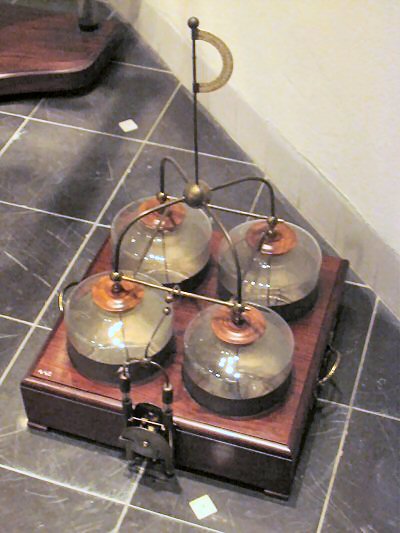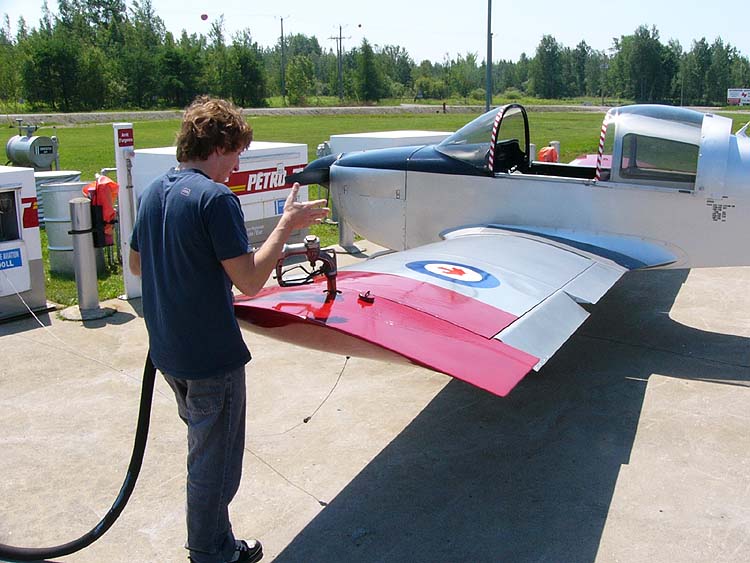|
Aircraft Fuel System
An aircraft fuel system allows the crew to pump, manage, and deliver aviation fuel to the propulsion system and auxiliary power unit (APU) of an aircraft. Fuel systems differ greatly due to different performance of the aircraft in which they are installed. A single-engine piston aircraft has a simple fuel system, while a tanker (such as the KC-135) not only manages its own fuel but can also provide fuel to other aircraft.Taylor 1990, p. 164. Fuel is piped through fuel lines to a fuel control valve (usually known as the fuel selector). This valve serves several functions. The first function is to act as a fuel shut-off valve. This is required to provide the crew with a means to prevent fuel reaching the engine in case of an engine fire. The second function is to allow the pilot to choose which tank feeds the engine. Many aircraft have the left tank and right tank selections available to the pilot. Some Cessna airplanes feed only from both tanks; and many have the option to feed ... [...More Info...] [...Related Items...] OR: [Wikipedia] [Google] [Baidu] |
Pump
A pump is a device that moves fluids (liquids or gases), or sometimes Slurry, slurries, by mechanical action, typically converted from electrical energy into hydraulic or pneumatic energy. Mechanical pumps serve in a wide range of applications such as Water well pump, pumping water from wells, aquarium filtering, pond filtering and Water aeration, aeration, in the car industry for Water cooling, water-cooling and fuel injection, in the energy industry for Pumping (oil well), pumping oil and natural gas or for operating cooling towers and other components of heating, ventilation and air conditioning systems. In the medical industry, pumps are used for biochemical processes in developing and manufacturing medicine, and as artificial replacements for body parts, in particular the artificial heart and Penile implant, penile prosthesis. When a pump contains two or more pump mechanisms with fluid being directed to flow through them in series, it is called a ''multi-stage pump''. T ... [...More Info...] [...Related Items...] OR: [Wikipedia] [Google] [Baidu] |
Capacitive
In electrical engineering, a capacitor is a device that stores electrical energy by accumulating electric charges on two closely spaced surfaces that are insulated from each other. The capacitor was originally known as the condenser, a term still encountered in a few compound names, such as the ''condenser microphone''. It is a passive electronic component with two terminals. The utility of a capacitor depends on its capacitance. While some capacitance exists between any two electrical conductors in proximity in a circuit, a capacitor is a component designed specifically to add capacitance to some part of the circuit. The physical form and construction of practical capacitors vary widely and many types of capacitor are in common use. Most capacitors contain at least two electrical conductors, often in the form of metallic plates or surfaces separated by a dielectric medium. A conductor may be a foil, thin film, sintered bead of metal, or an electrolyte. The nonconducting die ... [...More Info...] [...Related Items...] OR: [Wikipedia] [Google] [Baidu] |
Center Of Gravity
In physics, the center of mass of a distribution of mass in space (sometimes referred to as the barycenter or balance point) is the unique point at any given time where the weighted relative position of the distributed mass sums to zero. For a rigid body containing its center of mass, this is the point to which a force may be applied to cause a linear acceleration without an angular acceleration. Calculations in mechanics are often simplified when formulated with respect to the center of mass. It is a hypothetical point where the entire mass of an object may be assumed to be concentrated to visualise its motion. In other words, the center of mass is the particle equivalent of a given object for application of Newton's laws of motion. In the case of a single rigid body, the center of mass is fixed in relation to the body, and if the body has uniform density, it will be located at the centroid. The center of mass may be located outside the physical body, as is sometimes the c ... [...More Info...] [...Related Items...] OR: [Wikipedia] [Google] [Baidu] |
Bleed Air
Bleed air in aerospace engineering is compressed air taken from the compressor stage of a gas turbine, upstream of its fuel-burning sections. Automatic air supply and cabin pressure controller (ASCPC) valves bleed air from low or high stage engine compressor sections; low stage air is used during high power setting operation, and high stage air is used during descent and other low power setting operations. Bleed air from that system can be utilized for internal cooling of the engine, cross-starting another engine, engine and airframe anti-icing, cabin pressurization, pneumatic actuators, air-driven motors, pressurizing the hydraulic reservoir, and waste and water storage tanks. Some engine maintenance manuals refer to such systems as "customer bleed air". Bleed air is valuable in an aircraft for two properties: high temperature and high pressure (typical values are and , for regulated bleed air exiting the engine pylon for use throughout the aircraft). Uses In civil aircraft, ... [...More Info...] [...Related Items...] OR: [Wikipedia] [Google] [Baidu] |
Fuel Pump
A Fuel pump is a component used in many liquid-fuelled engines (such as petrol/gasoline or diesel engines) to transfer the fuel from the fuel tank to the device where it is mixed with the intake air (such as the carburetor or fuel injector). Carbureted engines often use low-pressure mechanical pumps that are mounted on the engine. Fuel injected engines use either electric fuel pumps mounted inside the fuel tank (for lower pressure manifold injection systems) or high-pressure mechanical pumps mounted on the engine (for high-pressure direct injection systems). Some engines do not use any fuel pump at all. A low-pressure fuel supply used by a carbureted engine can be achieved through a gravity feed system, i.e. by simply mounting the tank higher than the carburetor. This method is commonly used in carbureted motorcycles, where the tank is usually directly above the engine. Low-pressure mechanical pumps On engines that use a carburetor (e.g. in older cars, lawnmowers a ... [...More Info...] [...Related Items...] OR: [Wikipedia] [Google] [Baidu] |
Experimental Aircraft Association
The Experimental Aircraft Association (EAA) is an international organization of aviation enthusiasts based in Oshkosh, Wisconsin. Since its inception, it has grown internationally with over 300,000 members and nearly 1,000 chapters worldwide. It hosts the largest aviation gathering of its kind in the world, EAA AirVenture Oshkosh. History The EAA was founded in 1953 by veteran aviator Paul Poberezny along with other aviation enthusiasts. The organization began as more or less a flying club. Poberezny explains the nature of the organization's name, "Because the planes we flew were modified or built from scratch, they were required to display an EXPERIMENTAL placard where it could be seen on the door or cockpit, so it was quite natural that we call ourselves the "Experimental Aircraft Association". The EAA was incorporated in Wisconsin on 22 March 1955. Homebuilt aircraft, Homebuilding is still a large part of EAA, but the organization has grown over the years to include almost ... [...More Info...] [...Related Items...] OR: [Wikipedia] [Google] [Baidu] |
Aircraft Owners And Pilots Association
The Aircraft Owners and Pilots Association (AOPA) is a Frederick, Maryland-based American non-profit political organization that advocates for general aviation. AOPA's membership consists mainly of general aviation pilots in the United States. AOPA exists to serve the interests of its members as aircraft owners and pilots and to promote the economy, safety, utility, and popularity of flight in general aviation aircraft. With 384,915 members in 2012, AOPA is the largest aviation association in the world, although it had decreased in membership from 414,224 in 2010, a loss of 7% in two years. AOPA is affiliated with other similar organizations in other countries through membership in the International Council of Aircraft Owner and Pilot Associations (IAOPA). In 2015, AOPA was inducted into the International Air & Space Hall of Fame at the San Diego Air & Space Museum. In September 2024, the AOPA appointed Darren Pleasance as its sixth President and CEO. Pleasance, with extens ... [...More Info...] [...Related Items...] OR: [Wikipedia] [Google] [Baidu] |
Piper Aircraft
Piper Aircraft, Inc. is a manufacturer of general aviation aircraft, located at the Vero Beach Regional Airport in Vero Beach, Florida, United States and owned since 2009 by the Government of Brunei. Throughout much of the mid-to-late 20th century, it was considered to be one of the "Big Three" in the field of general aviation manufacturing, along with Beechcraft and Cessna.Pattillo (1998), p. 83 Between its founding in 1927 and the end of 2009, the company produced 144,000 aircraft in 160 certified models, of which 90,000 are still flying. History The company was founded as the Taylor Brothers Aircraft Manufacturing Company in September 1927 by brothers Clarence G. Taylor and Gordon A. Taylor in Rochester, New York. The company was renamed Taylor Brothers Aircraft Corporation in April 1928, shortly before Gordon Taylor died in an aircraft accident flying one of the brothers' own designs, a Taylor Chummy, on April 24, 1928. The company was enticed to move to Bradford ... [...More Info...] [...Related Items...] OR: [Wikipedia] [Google] [Baidu] |
Aviation Consumer
Aviation includes the activities surrounding mechanical flight and the aircraft industry. ''Aircraft'' include Airplane, fixed-wing and Helicopter, rotary-wing types, morphable wings, wing-less lifting bodies, as well as Aerostat, lighter-than-air aircraft such as Balloon (aeronautics), hot air balloons and airships. Aviation began in the 18th century with the development of the hot air balloon, an apparatus capable of atmospheric displacement through buoyancy. Clément Ader built the "Ader Éole" in France and made an uncontrolled, powered hop in 1890. This was the first powered aircraft, although it did not achieve controlled flight. Some of the most significant advancements in aviation technology came with the controlled gliding flying of Otto Lilienthal in 1896. A major leap followed with the construction of the ''Wright Flyer'', the first powered airplane by the Wright brothers in the early 1900s. Since that time, aviation has been technologically revolutionized by the ... [...More Info...] [...Related Items...] OR: [Wikipedia] [Google] [Baidu] |
Ultralight Aircraft
Ultralight aviation (called microlight aviation in some countries) is the flying of lightweight, 1- or 2-seat fixed-wing aircraft. Some countries differentiate between weight-shift control and Aircraft flight control system, conventional three-axis control aircraft with ailerons, Elevator (aircraft), elevator and Rudder#Aircraft rudders, rudder, calling the former "microlight" and the latter "ultralight". During the late 1970s and early 1980s, mostly stimulated by the hang gliding movement, many people sought affordable powered flight. As a result, many aviation authorities set up definitions of lightweight, slow-flying aeroplanes that could be subject to minimum regulations. The resulting aeroplanes are commonly called "ultralight aircraft" or "microlights", although the weight and speed limits differ from country to country. In Europe, the sporting (FAI) definition limits the maximum stalling speed to and the maximum take-off weight to , or if a ballistic parachute is install ... [...More Info...] [...Related Items...] OR: [Wikipedia] [Google] [Baidu] |
Avgas
Avgas (aviation gasoline, also known as aviation spirit in the United Kingdom, UK) is an aviation fuel used in aircraft with spark-ignited internal combustion engines. ''Avgas'' is distinguished from conventional gasoline (petrol) used in motor vehicles, which is termed ''mogas'' (motor gasoline) in an aviation context. Unlike motor gasoline, which has been formulated without lead since the 1970s to allow the use of catalytic converters for pollution reduction, the most commonly used grades of avgas still contain tetraethyllead, tetraethyl lead, a toxic lead-containing additive used to aid in lubrication of the engine, increase octane rating, and prevent engine knocking (spark-knock). There are ongoing efforts to reduce or eliminate the use of lead in aviation gasoline. Kerosene-based jet fuel is formulated to suit the requirements of gas turbine, turbine engines which have no octane requirement and operate over a much wider flight envelope than piston engines. Kerosene is also ... [...More Info...] [...Related Items...] OR: [Wikipedia] [Google] [Baidu] |









